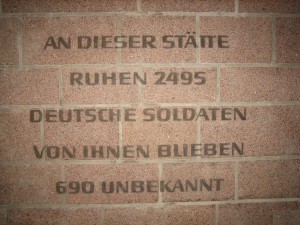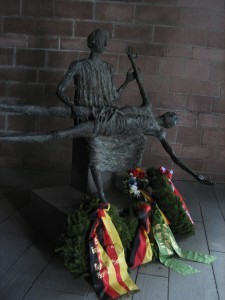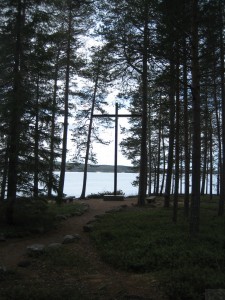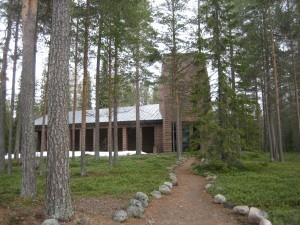There is a German soldiers’ cemetery at Norvajärvi, 18 km north of Rovaniemi. It was founded on August 31, 1963. The mausoleum is the resting place for more than 2 500 Germans who fell in the World War II. As I had heard of this cemetery and never visited it, I the other day went to find out how it looked like. It was much bigger than I had imagined. The whole area and the mausoleum was a very peaceful and beautiful place heading to the lake of Norvajärvi.
It is easy to find the way to the cemetery. There are signs to show the way starting in Rovaniemi and from the parking area there is a 0,5 km walk along a sandy path. The mausoleum is visited by a lot of German tourists and relatives to the soldiers during the summer season, but also now in April there had been visitors putting flowers on the grave; supposedly they were also relatives.
In the World War II about 15 000 German soldiers fell at the Finnish border. Most part of them are buried on Russian ground. There are two main cemeteries for German soldiers founded in Finland; one in Helsinki and one here at Norvajärvi, Lapland. There were all together about 200 000 German soldiers in Lapland during the Continuation War 1941-1944. 
The area of this cemetery is about 16 000 m² on the shore of the lake Norvajärvi. As you enter the mausoleum you first find the statue named: “Mother and son”. A very touching sight. In the mausoleum there are 8 big boards with all the 2 500 names of the fallen German soldiers. In a book at the entry you can search for special names and find out on which of the boards they are to be found. It is an impressive amount of names carved on the boards!
On the shore of the lake there is a big iron cross and a place to sit down and gather thoughts and enjoy the peace of the area. The mausoleum is open to the public on April-September.
A little history around the Lapland War (to be read only by those, who are interested in learning more about the Germans in Lapland):
The Lapland War was fought between Finland and Nazi Germany from September 1944 to April 1945 in Lapland. A peculiarity of the war was that the Finnish army was forced by the Soviet Union to demobilize their forces while at the same time they were fighting to force the German army to leave Finland. German forces retreated to Norway, and Finland managed to uphold its obligations to the Soviet Union, until the formal conclusion of the Continuation War was ratified by the 1947 Paris peace treaty.
Germany and Finland had been at war with the Soviet Union since June 1941, co-operating closely in the Continuation War. However, as early as the summer of 1943, the German High Command began making plans for the eventuality that Finland might make a separate peace agreement with the Soviet Union. The Germans planned to withdraw their forces northward to shield the nickel mines near Petsamo.
During the winter of 1943–1944, the Germans improved the roads from northern Norway to northern Finland by extensive use of prisoner of war -labour in certain areas. Casualties among these prisoners were high, in part because many of them had been captured in southern Europe and were still in summer uniform. In addition, the Germans surveyed defensive positions and made plans to evacuate as much material as possible from the region.
Change of Finnish leadership led the Germans already in early August 1944 to believe that Finland would attempt to make a separate agreement with the Soviet Union. The Finnish announcement of the cease-fire triggered frantic efforts in the German Army which immediately started material evacuations from Finland. Large amounts of material were evacuated from southern Finland and harsh punishments were set for any hindering of the withdrawal.
By 15 September 1944 a secret agreement had been reached by which the Germans would make their withdrawal timetable known to the Finns, who would then allow the Germans to destroy roads, railroads and bridges. In practice, friction soon arose both from the destruction caused by the Germans and from the pressure exerted on the Finns by the Soviets, and there were several incidents between the armies.
At Rovaniemi the Germans initially concentrated mainly on destroying governmental buildings but once fire got loose they were forced to destroy several more. German attempts to fight the fire however failed and a train loaded with ammunition caught fire at Rovaniemi railroad station on 14 October resulting in a massive explosion which caused further destruction as well as spreading the fire throughout the primarily wooden buildings of the town. German attempts to fight the fire had failed by the time, on 16 October, they abandoned the now ruined town to the advancing Finns.
In the museum of Arktikum in Rovaniemi you can learn more about the Lapland War.




